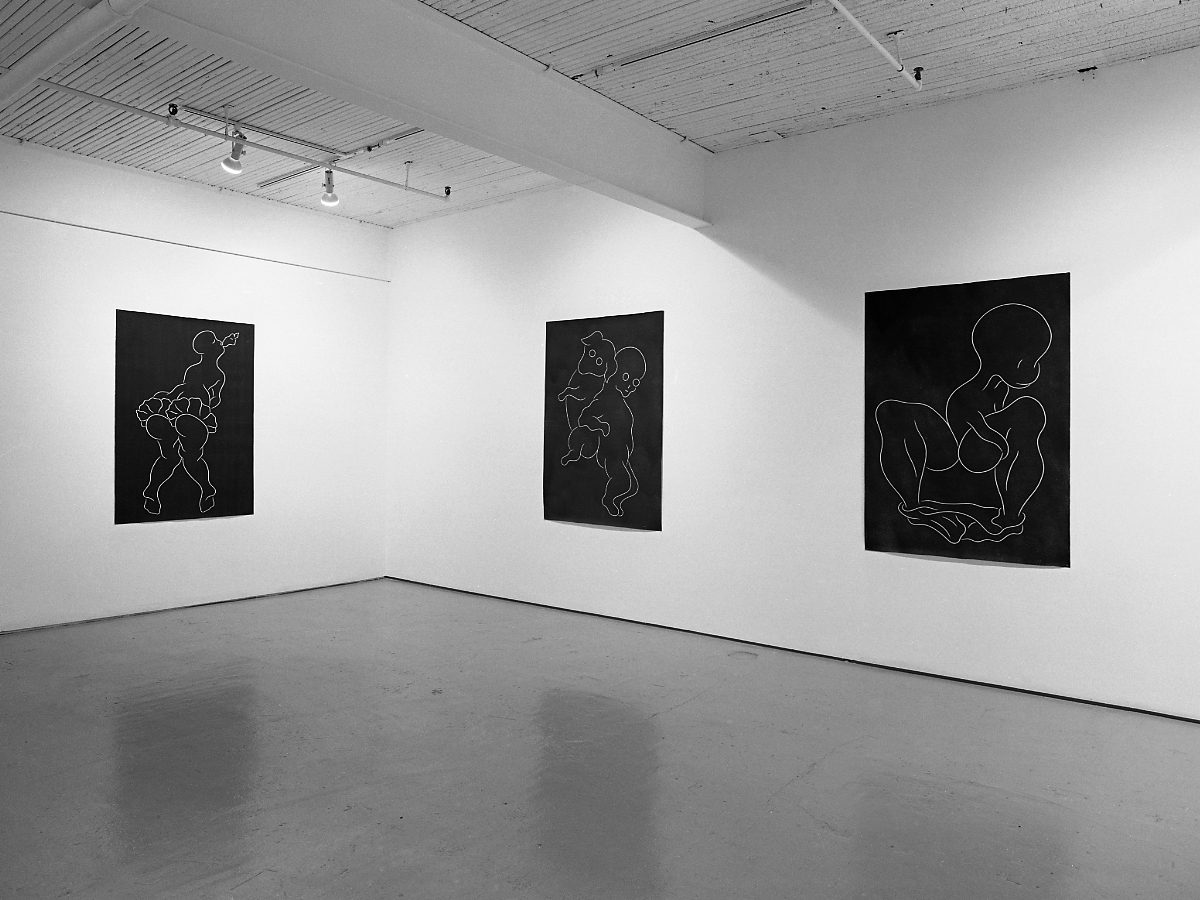Works on Canvas:
This solo exhibition by Swiss artist Aldo Walker features nine paintings, 160 cm x 120 cm, executed in acrylic on canvas. Concerned with analytic or semiotic philosophy, the paintings by Aldo Walker stand as illustrations of the dissonant relationship between the sign and the signified. Employing the impersonal character of the two-dimensional surface of the canvas, Walker draws constellations of radically simplified figures with clearly delineated outlines. The seemingly external banality of these precise drawings, however, gives way to a sense of perplexity; the apparent clarity of the well-defined pictograms begins to waver and the viewer's perception is shaken. On closer inspection, the reading of these concrete objects is ambiguous. Is the figure an animal or a man or both in one? Where does one meet the other? What causes the reversal of one's point of view, and how has this perspective been implemented?
"Aldo Walker invites us into a veritable school of seeing, leading us into the world of the undifferentiated, onto the swaying stage of appearance and being, of image and copy, of illusion and reality. One can see this as a consequential continuation of the intentions of conceptual art with new means of painting and drawing".
Marianne Eigenheer
Aldo Walker
Mercer Union
Toronto
January 14 to February 8
Jerry McGrath
Vanguard, April 1986
In a show curated by Andreas Gehr, these two Swiss artists fall into the same camp when compared superficially. Eigenheer and Walker show a similar spareness of line held to the sober project of examining perception.
Walker's images are white outlines on a matte-black ground. Immediately noticeable is their resemblance to the kitsch side of black-velvet painting. Whatever the extent of such example in Europe, one may suppose the North American viewer to be wary of how the artist begins to engage us. A gallery statement assures us that Walker's works are "illustrations of the dissonant relationship between the sign and the signified." In pursuit of this failed congruence he can follow the semiologists and dig down low. Many of his figures have the infantile porkiness of Elmer Fudd minus shotgun, hunting hat and all. And. with all else out of the way, we can recall Hans Bellmer, whose cool eye reflected the cold bottoms of dolls. The human and the porcine find other points or similarity in the treatment of the limbs; the near-human, to be more accurate, is often given what might be either short trotters or fins. A few other illustrations show these cartoonish creations defecating and urinating. Following Bataille, Walker wants to deconstruct our moral equipment. Bataille invoked chickens by having his little heroine break eggs with her arse; to seek for himself our acquittal Walker goes back to the barnyard.
Eigenheer's perspective, according to a gallery statement, is feminist: "she views the new painting as patriarchy's last desperate stand." Her means in this show are almost exclusively two meandering lines of different colour promising, but never strongly conferring, objecthood. Yet, elements can be recognized from modern art; from Picasso she gets a stylized knife-wielding hand - fat butt-ends of finger ranged along an edge of an abstract form and a simple horn of the saucer-on-a stick variety. Something of Dubuffet runs through her robust line, colonizing space not in order to build there a house, a fence or a tree but simply to be only what modernism asked of it: itself. Patriarchy's last stand seems to be taking place in Eigenheer's own psyche. Is this a process of exorcism? Is this gnarled, ginger-root profusion the departure of those spirits? If borrowing is more her purpose, then it seems only an intermittent need. More often than not her lines seek the self-sufficiency which emerged from abstraction. Indeterminacy may be the condition she thinks necessary to engage the viewer via his/her subjectivity (as if being more forthright as an artist might emulate a didactic model). However, there is too much of it.

